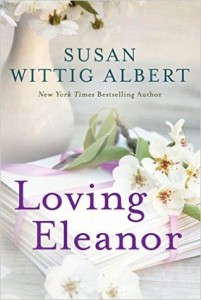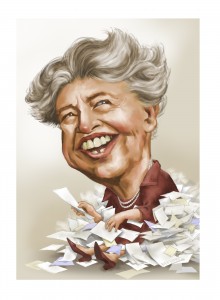 Loving Eleanor: The Intimate Friendship of
Loving Eleanor: The Intimate Friendship of
Eleanor Roosevelt and Lorena Hickok
by Susan Wittig Albert
Persevero Press. 305 pages, $26.95
FOR NEARLY the last one hundred years, it has been rumored—and quite convincingly rumored, it must be stated—that First Lady Eleanor Roosevelt had love affairs with other women and that she was, if not a lesbian, at least a bisexual woman. In her new novel Loving Eleanor, Susan Wittig Albert imagines how one of the more well-documented relationships might have started, progressed, and concluded.
In 1928, Lorena Hickok was an up-and-coming writer for the Associated Press at a time when high-level women journalists were rare. She had moved to New York City from Minneapolis, where she’d had a newspaper job and a long-term relationship with another woman. This connection was the stuff of gossip and was rarely discussed without smirking titillation; needless to say, a lesbian affair was quite scandalous at the time. In New York, Hickok was seeking to establish a reputation for her work on hard-hitting newswire investigations.
 This was also the year that she met Mrs. Roosevelt, as Hickok, the narrator of the novel, initially calls the future first lady. FDR, as “Hick” sometimes refers to Franklin D. Roosevelt, was just gearing up his involvement in national politics, while his wife was a relatively unwilling participant in public life and hated the spotlight (that would change). Eleanor Roosevelt was something of a physical anomaly: tall and not particularly easy on the eyes, she wanted to be more than the usual Jazz Age woman. Although the idea of leaving New York for Washington vexed her, she wanted to be an agent of social change.
This was also the year that she met Mrs. Roosevelt, as Hickok, the narrator of the novel, initially calls the future first lady. FDR, as “Hick” sometimes refers to Franklin D. Roosevelt, was just gearing up his involvement in national politics, while his wife was a relatively unwilling participant in public life and hated the spotlight (that would change). Eleanor Roosevelt was something of a physical anomaly: tall and not particularly easy on the eyes, she wanted to be more than the usual Jazz Age woman. Although the idea of leaving New York for Washington vexed her, she wanted to be an agent of social change.
Her life largely revolving around her job and her dog, Hick was 35 at the time of this encounter, more than a decade younger than Mrs. Roosevelt, and also, as she admits ruefully in this novel, no beauty. What she lacked in looks, however, she made up for in tenacity when it came to finding a good story. Through connections she met the larger-than-life Mrs. Roosevelt and was impressed by the older woman’s charisma. Eleanor, in this novel, had recently ended a shocking, closer-than-kosher friendship with a young man. She seemed almost immediately taken with Hickok and fed her exclusive quotations and information for the AP, including a lot of secrets that were “off the record.” Albert’s Hickok seems at this point in the story to be quite star-struck and vulnerable. Nevertheless, a friendship quickly formed, one that that was documented in hundreds of passionate archived letters, which strongly point to a (possibly rather chaste) love affair, notwithstanding some historians’ continued skepticism. The fact that FDR tried to engineer an end to the affair is itself somewhat revealing.
While this thoroughly researched book offers quite a bit of historical factuality—small nuances of everyday pre-Depression life leading into Depression-era hardships faced by Americans in several hard-hit parts of the country, descriptions of social programs that were part of the New Deal, news about politics and foreign wars, glimpses into the lives of the key players in the Roosevelt White House—readers should never lose sight of the fact that this is a romance novel. Albert, in fact, says in her biographical afterword that she exercised some license with a few threads of the story, such as dates and events at which the love affair between Hickok and Roosevelt developed.
The fabricated bits fit together seamlessly enough, and few readers will notice their inclusion in historical events. What reminds us that this is a novel is the florid dialogue, the schoolgirl sentiments, the expressions of angst that go well beyond what might be expected of two such powerful—but also decorous—women. Add to these melodramatic elements a plot that’s often very slow, and the rationale for a novel about the affair seems open to question. Those curious about the times and the true relationship of Hickok and Roosevelt may be better served by a nonfiction book.






